Short Book Reviews
Hanna Kryszewska, Poland
Hanna Kryszewska is a teacher, teacher trainer, trainer of trainers. She is a senior lecturer at the University of Gdańsk, and EU Teacher Training College where she trains pre-service teachers. She is co-author of resource books: Learner Based Teaching, OUP, Towards Teaching, Heinemann, The Standby Book, CUP, Language Activities for Teenagers, CUP, The Company Words Keep, DELTA Publishing, and a course book series for secondary schools: ForMat, Macmillan. She is also co-author of a video based teacher training course: Observing English Lessons. Hania is a Pilgrims trainer and editor of HLT Magazine.
E-mail: hania.kryszewska@pilgrims.co.uk

Gateway GOLD 1. Pupil’s Book. Gateway GOLD 1. . ISBN 978-1-78260-081-7, pp.120. Activity Book. Gateway GOLD 1. ISBN 978-1-78260-083-1, pp.95. Teacher’s Book. ISBN 978-1-78260-082-4, pp.260. J. Greenwell and S. Lawrence. (2014) Garnet Education. Gateway Gold is a new seven level English language which course starts at beginner level and goes up to intermediate level (B1), and is aimed at learners from five to twelve years old. However, in Gateway Gold 1 the authors introduce activities based on reading and writing (literacy based tasks), which will make the book unsuitable for some schools or educational systems in countries where text-free period in language teaching ends at the age of five. The book has a strong lexical and functional focus, teaching whole phrases and sentences to be used in particular situations. The book also introduces elements of CLIL, critical thinking and creativity. Unfortunately, the illustrations, artwork and in-house characters are reminiscent of course books for young learners published in the sixties of the last century. Children aged five might respond well to this kind of style, however, it will be interesting to see how the artwork of the course will change as the learners grow older. The course book comes with a workbook, a very supportive teacher’s book, picture and word flashcards, a grammar book, a phonics book, DVD’s and CD’s, and an interactive CD-ROM.
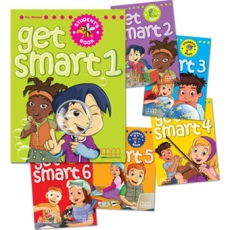
Get smart British edition.. H.Q. Mitchell and M. Malkogianni. mm publications
Get smart 2. Teacher’s book. (2012). ISBN 978-960¬-478-846-0, pp.200.
Get smart 4. Teacher’s book. (2013). ISBN 978-960¬-478-852-1, pp.200.
Get smart is a six level primary course for young learners in primary education. It takes the learners from the beginners level up to pre-intermediate level (A2). The course is learner centered and it actively engages the children. They not only learn how to use the language, but also explore the environment around them and interact with other learners. The authors have called their approach the ‘building block strategy’ which involves careful presentation and frequent revisions of every new lexical item or grammatical structure. The book has a good balance of the four skills integrated with cross-curricular content such as health – eating the right food, art – making something new from something old, science – germs, or social studies – safety at home. Although some are not quite convincing like: art – making a favourite means of transport, music – a song, or English – fiction, writing about one’s favourite animal. The two parts I have looked at also contain a phonics section, in which phonemic awareness is developed, and the correlation between sounds in speaking and letter combinations in writing are explored. The question remains at what point young language learners no longer need phonics and when to stop teaching it. With native children the moment comes when they can correctly read words they do not know; surely there needs to be a cut off point when you are learning a foreign language. The illustrations and artwork are a mixture of drawings, cartoons and photographs, and the in-house characters are children who are the same age as the language learners using the book. However, the book covers are not very appealing. Each course book is accompanied by a full-colour workbook with a free CD/CD-ROM, flashcards, a separate grammar book, interactive whiteboard material, a DVD and activity book, and, of course, a teacher’s book.
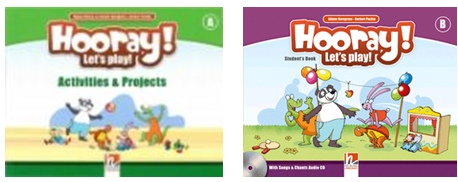
Hooray!: Let’s play! Activities & Projects A ISBN 978-3-85272-964-0 pp. 48, Hooray!: Let’s play! Activities & Projects B ISBN 978-3-85272-965-7 pp. 48, Hooray!: Let’s play! Activities & Projects Guide A ISBN 978-3-85272-921-3 pp. 128, Hooray!: Let’s play! Activities & Projects Guide B ISBN 978-3-85272-922-0 pp. 132. M. Cherry with G. Gerngross and H. Puchta. (2014). Helbling Languages. The publications accompany the highly successful course published in 2012. The new components supplement the course book and introduce additional activities related to CLIL, developing motor skills, citizenship, critical thinking, cognitive skills and drama. Sample activities are devoted to naming shapes, tracing and drawing shapes, what happens when you inflate or deflate a balloon, acting out a story, putting a story in order, recognising and naming the five senses, chanting, recognising and naming different forms of transport, what happens to objects when they are placed in water, learning how sounds are made, playing games, the importance of washing hands and many others. The activities offer the children an opportunity to engage and interact, and to learn about the surrounding world and themselves. The student’s workbook can be used as a whole book or individual tear out worksheets. The illustrations and artwork echo the course books and uses the same in-house characters. The teacher’s book offers the teacher step by step guidance how to use the material as well as additional ideas which can be used to supplement and enrich the lessons. This is a very valuable publication which adds more depth to the course.
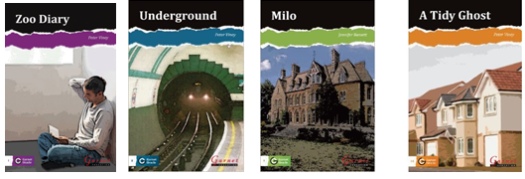
Garnet Oracle Readers. Garnet Education.
Level 1 - Zoo Diary. P. Viney. ISBN 978-1-90757-520-4, pp 32. (2013)
Level 2 - Underground. P. Viney. ISBN 978-1-90757-527-3, pp 40. (2014)
Level 3 - Milo. J. Bassett. ISBN 978-1-90757-516-7, pp 48. (2014)
Level 4 - A Tidy Ghost. P. Viney. ISBN 978-1-90757-523-53, pp 40. (2013)
Readers in this new series of graded reading materials for language learners come at four levels, level 1 – 400 headwords, level 2 – 750 headwords, level 3 - 1 000 headwords, level 4 – 1 250 headwords. The series editor and the author of a number of the readers in the series is an experienced teacher and author of ELT materials, including graded readers for various publishers. His expertise is clearly visible in the choice of texts, the topics and the variety. Some of the stories are narratives; some come in the form of a diary or dialogues. The illustration and visual materials include pictures in various styles, maps, photographs and diagrams. The stories are very well written and a pleasure to read – a teenager kidnapped by aliens, secrets of the London Underground discovered by a night cleaner, a mystery story, the relationship between a student and a teacher, or a modern house haunted by a tidy ghost. The stories are accompanied with resource pages, activity pages and a glossary explaining some of the more difficult words used in the text. At the moment there are four titles available at each level. Let us hope there are more to come. For more go to
www.garneteducation.com/Subject/59/Garnet_Oracle_Readers.html
peterviney.wordpress.com/elt-archive/garnet-oracle-readers/
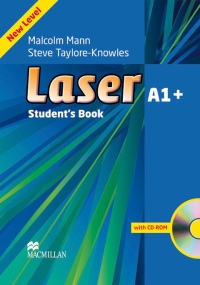
Laser: Student’s Book A1+. M. Mann and S. Taylore-Knowles. Macmillan (2012) ISBN 978-0-230-47065-1, pp 160. This book is a new addition to the well established three part general English course aimed at teenagers. This course book, just like the other books in the series, reflects the needs and interests of the learners. The book is divided into fourteen topic based units with comprehensive skills coverage, grammar and vocabulary practice. The topics are relevant to this particular age group and include cross-curricular and intercultural content, as well as tasks which require the use of English in the learners’ own environment. The course has a skills based approach, in which language functions, grammar and lexis are closely linked to the skills themselves. Production of language requires speaking and writing using motivating activities close to life. The strong points of the course are: the Language Lab, writing planners, the Phrase Bank, the Sound Spot sections, additional materials in workbook to be used as homework and a student’s CD-ROM. The book like all the other parts in the course is pleasing to the eye with a clear layout and reasonably good photography and drawings. The book nicely completes theh course.
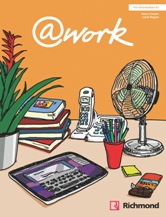
@ work. A. Cowper and L. Rogers. (2013). ISBN 978-84-668-1363-1, pp 128. The book is part of a four level course aimed at those who currently need to communicate in English at work or those who know that their future working environment will require using English. The choice of topics is relevant to the learners, for example: talking about yourself and small talk, meeting people, working life, new ideas, life coaching, being under pressure, careers, planning ahead, selling products and financial matters. The learners get a lot of opportunities to practise language and various language skills through engagement in motivating real-life activities. The main aim of the book is preparing for oral and written communication, and so grammar and vocabulary learning are geared to serve this aim. What stands out is the e-mail writing section which teaches and coaches how to successfully communicate for work purposes. This is a truly modern book which is accompanied by a learning platform, a digital workbook, business maze apps and video skills modules. However, I am not sure how the authors or publishers interpret the CEFR levels, as they say that the book is at pre-intermediate level i.e B1, whereas sually B1 is intermediate level. This may be confusing for the learners and teachers, or worse could lead to unsuitable choice of the book with regard to the level.
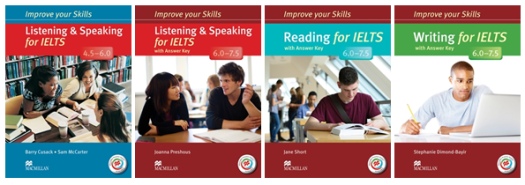
Improve your Skills Series. (2014). Macmillan
Listening & Speaking for IELTS 4.5-6.0 with Answer Key. B. Cusack and S. McCarter. ISBN 9780230464681, pp 118.
Listening & Speaking for IELTS 6.0-7.5 with Answer Key. J. Preshous. ISBN 9780230463417, pp 118.
Reading for IELTS 4.5-6.0 with Answer Key. S. McCarter and N. Whitby. ISBN 9780230462114, pp 96.
Reading for IELTS 6.0-7.5 with Answer Key. J. Short. ISBN 9780230463394, pp 92.
Writing for IELTS 4.5-6.0 with Answer Key. S. McCarter and N. Whitby. ISBN 9780230462168, pp 112.
Writing for IELTS 6.0-7.5 with Answer Key. S.Diamond-Bayir. ISBN 9780230463400, pp 108.
This is a six book series for learners who are preparing for the IELTS exam; three books are aimed at lower level learners i.e. those who are likely to get 4.5-6.0 exam result, and three books at higher level learners i.e. those who are in the 6.0-7.5 result bracket. The publishers have separated the exam skills, and so at a given level there is: Listening & Speaking, Reading and Writing. Each of the books contains an introduction to the given part or parts of the exam it is devoted to, and then is divided into topic based units which provide or revise the language and grammar, and develop the skills necessary to perform well in the exam. For example, in Listening & Speaking the learners become familiar with the listening exam tasks and topics which can appear in the oral exam questions. In Reading the focus in on lexis and techniques improving reading comprehension skills. In Writing learners work on improving their exam performance by planning, evaluating and prioritising, using paragraphs, or understanding purpose. Additionally, Listening comes with two CD’s, and there are more exam practice exercises and interactive tasks to develop IELTS skills. The IELTS Skills Apps are available from
www.macmillaneducationapps.com/ieltsskills/
The books can be used in class or as self-study material if the student has access to the edition with the answer key. For more see
www.macmillanenglish.com/courses/improve-your-skills-for-ielts/
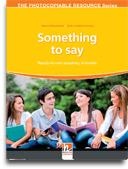
Something to say. Ready-to-use speaking activities. T. Woodward and S. Lindstromberg. (2014). ISBN 978-3-85272-780-6. Helbling Languages, pp 160. The book has been published in The Photocopiable Resource Series which established its reputation as a series which combines classroom routines with innovative and creative techniques. Teachers are always looking for ready-to-use innovative materials and this series responds to this need. The authors of the book are seasoned teachers, teacher trainers and authors of ELT materials. Something to say offers a wealth of speaking activities which are ready to use. They include intonation when speaking, interviews, asking questions and answering surprise questions, questionnaires with a grammar slant, topic based questionnaires, and using conversational frames. The materials in the book are suitable for teenage learners and above, and those whose language competence starts at upper elementary. Many of the activities are suitable for advanced learners. The techniques used in the book include confidence building when speaking like repeating after a model, reciting and chanting, participation in milling around activities using the photocopiable questionnaires, speaking with the help of visual materials, story telling, planning and rehearsing what to say, reaching consensus, taking part in group discussions or debates, giving a talk, and performing sketches and short plays. The ideas and activities in the book are a lot of fun, however, they have a sound methodological underpinning. They recycle or reinforce lexical areas or selected grammar structures. The activities challenge the learners in a way that will motivate the learners. The activities will take from a few to 45 minutes, but they can be adapted, shortened or lengthened according to the needs of the learners. Teachers will like the fact that the materials involve hardly any preparation on their part, and are easy to use. Highly recommended.
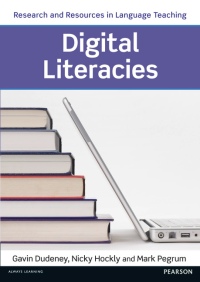
Digital Literacies. G. Dudeney, N. Hockly and M. Pegrum. Pearson (2013). ISBN 978-1-4082-9689-9. pp 387. This book is published in the new Research and Resources in Language Teaching series, eds. Jill Hadfield and Christopher. N. Candlin. It is a ground breaking series which combines the most recent research and state of the art classroom practice. Digital literacy is becoming a must although many teachers are still resisting. Digital immigrants sometimes do not understand digital natives who don’t know a world without computers, ICT, social media, apps just to name a few. The major concern is that computers will replace teachers, which is pretty unlikely. But what is certain – teachers who use computers in the broad sense will replace those who don’t. The book helps teachers to go beyond traditional language teaching which involves print literacy and take on board the fact that digital literacy is one of the 21st century skills, next to creativity, innovation, working in teams, and ability to retrain and adapt throughout the working life. Like all the other titles in the series the book strikes a balance between theoretical underpinning and practical activities. The general considerations address such questions as what hardware and software is required, the role of facebook, alternatives to Google, how much can Wikipedia be trusted and relied on, information overload, multitasking, copyright and plagiarism, and what ‘new technologies mean for people and the planet’. In the research part of the book the authors refer to the TPACK model for incorporating technology, pedagogy and content knowledge presented by Mishra and Koehler, and the SAMR model (substitution, augmentation, modification and redefinition) for evaluating technology by Puentedura. The practical activities section starts with a digital activities grid with focus on language, information, connection and re-design, and a digital tools grid which lists the key types of software, web tools and apps used in the activities. Then 50 practical activities follow; they are suitable for secondary and adult learners, but I am sure teachers of younger learners will finds ways of adapting the activities.
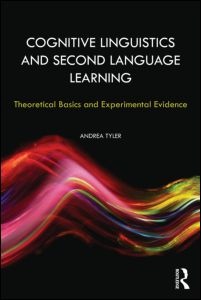
Cognitive Linguistics and Second Language Leraning. Theoretical Basics and Experimental Evidence. A. Tyler. Routledge. (2012) ISBN 978-0-415-80250-5. pp 252. This book stands out as it is one of the first if not the first publication which applies cognitive linguistics to learning a foreign language. The main premise is that learning a language has a cognitive, social and purely physical dimension. First the author looks at the current state of cognitive linguistics and the basics of cognitive linguistics. The book has sound theoretical underpinning and is supported by empirical research which looks at applying cognitive linguistics to English modal verbs, English prepositions, and clause level construction. Finally, the author draws conclusions and maps out possible developments in the future. Not to be missed are the appendices with sample materials. This is a very useful publication for experienced ELT trainers and lecturers, especially on undergraduate university courses.

Please check the Methodology and Language for Primary Teachers course at Pilgrims website.
Please check the Methodology and Language for Secondary Teachers course at Pilgrims website.
Please check the Teaching Advanced Students course at Pilgrims website.
Please check the Creative Methodology for the Classroom course at Pilgrims website.
Please check the Methodology for Teaching English Spoken Grammar course at Pilgrims website.
Please check the Using Mobile Technology course at Pilgrims website.
Please check the ICT - Using Technology in the Classroom – Level 1 course at Pilgrims website.
Please check the ICT - Using Technology in the Classroom – Level 2 course at Pilgrims website.
Please check the Using Interactive Whiteboards course at Pilgrims website.
Please check the How to be a Teacher Trainer course at Pilgrims website.


|